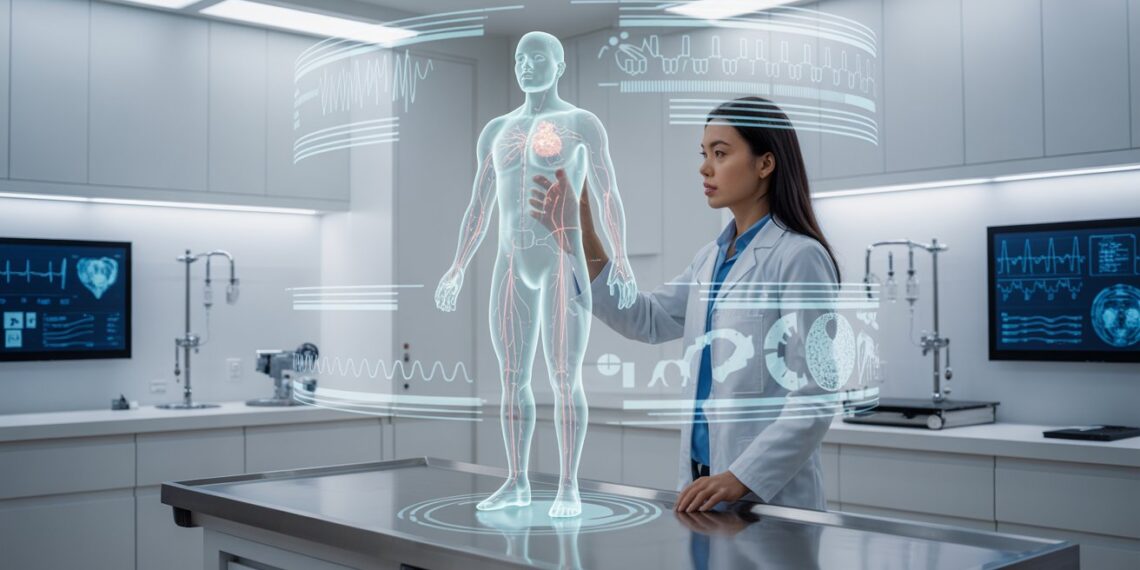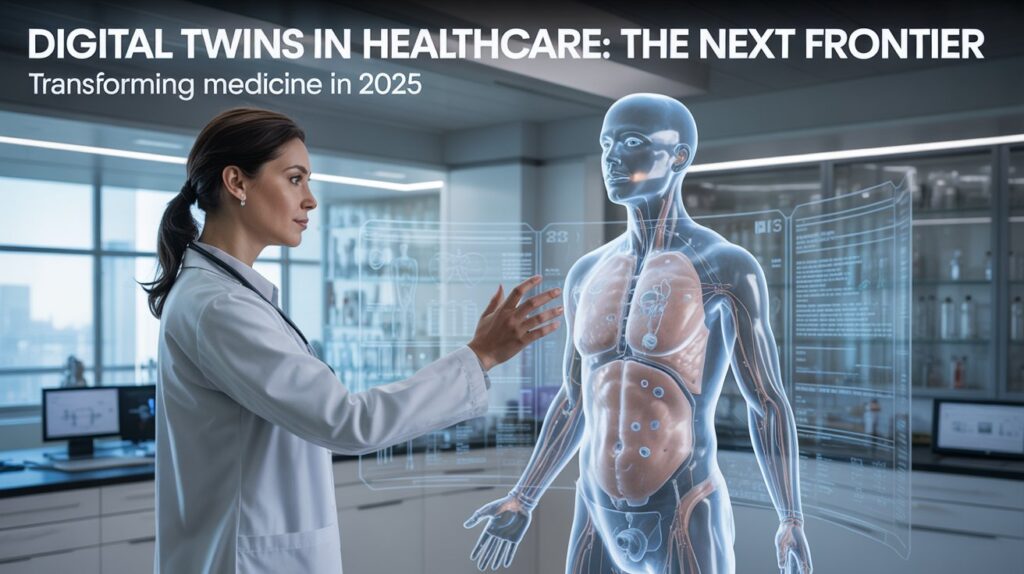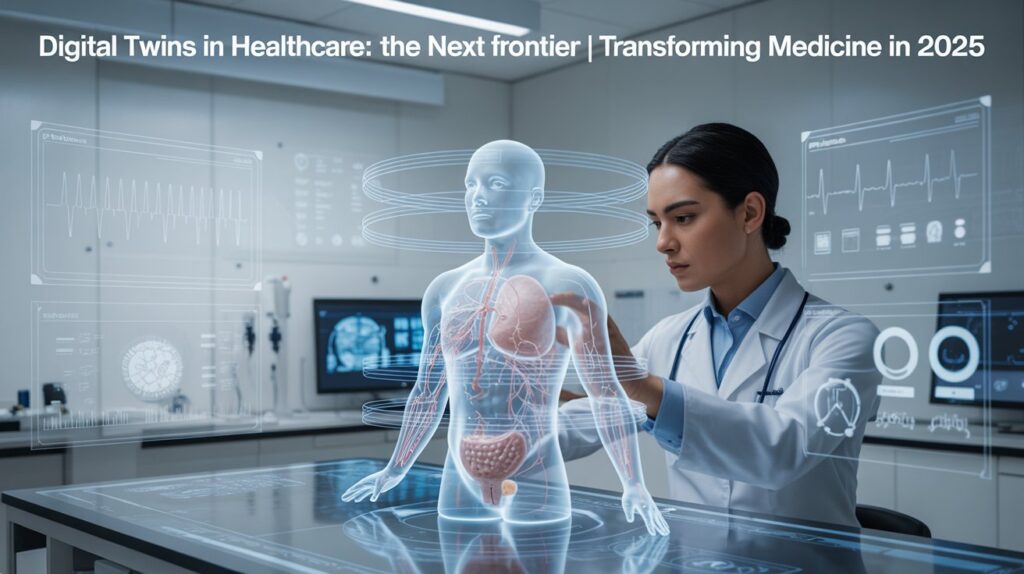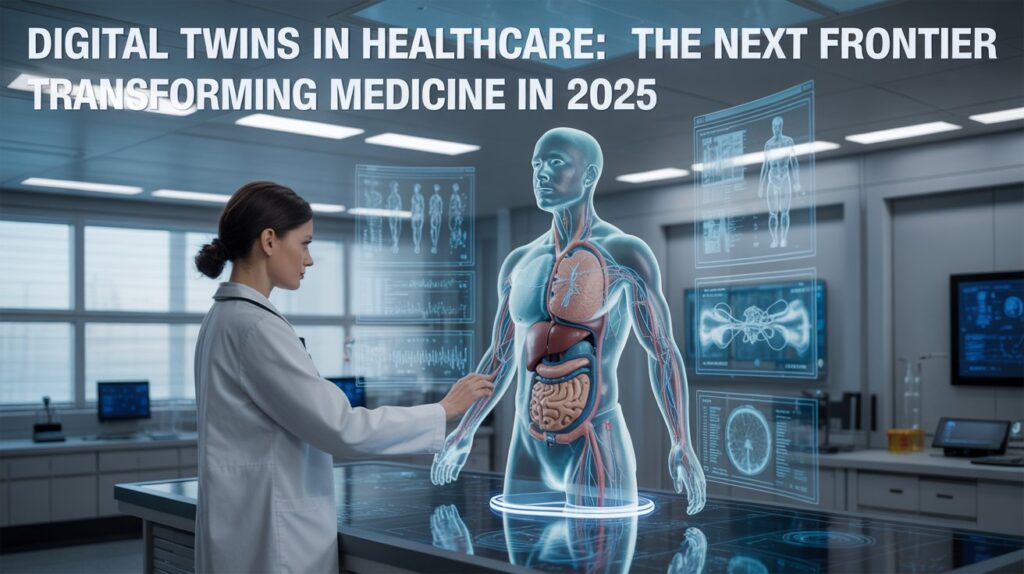Healthcare is undergoing one of the most transformative shifts in modern history, fueled by the convergence of digital technologies, data science, and artificial intelligence. Among these innovations, digital twins are rapidly emerging as a groundbreaking concept with the power to reshape how we understand, diagnose, and treat human health.
In manufacturing and engineering, digital twins—virtual replicas of physical systems—have already proven their worth in optimizing performance and predicting maintenance needs. Now, as data-driven medicine evolves, the same concept is revolutionizing the medical field. This article explores Digital Twins in Healthcare: The Next Frontier, revealing how virtual patient models, hospital simulations, and predictive analytics are setting new standards for personalized and preventive care.
What Is a Digital Twin?
A digital twin is a virtual model that mirrors a physical object, process, or system using real-time data. In healthcare, a digital twin can represent anything from a single organ to an entire hospital system—or even an individual patient.
By continuously syncing data from sources such as electronic health records (EHRs), imaging technologies, wearable sensors, and genomics, these virtual replicas can simulate, predict, and optimize real-world outcomes.
How It Works in Healthcare
-
Data Collection: Information from sensors, medical devices, and clinical databases is gathered.
-
Model Creation: Advanced algorithms, often driven by AI and machine learning, create a digital model of the biological or operational system.
-
Simulation & Prediction: Clinicians can test interventions virtually, predict outcomes, and personalize treatments before applying them in real life.
-
Continuous Feedback: The digital twin learns and evolves as more data is collected, becoming an increasingly accurate representation of its real-world counterpart.
This dynamic feedback loop allows healthcare professionals to predict disease progression, simulate surgical procedures, and optimize resource allocation—all in a risk-free environment.
Applications of Digital Twins in Healthcare
Digital twin technology is unlocking new possibilities across the healthcare spectrum—from individual patient care to large-scale operational management.
1. Personalized and Predictive Medicine
One of the most promising applications of digital twins lies in personalized medicine. By integrating genetic, physiological, and lifestyle data, digital twins allow clinicians to simulate how a specific patient might respond to a treatment or drug.
-
Example: A digital twin of a heart can simulate how different medication dosages affect a patient’s cardiovascular system.
-
Impact: Physicians can choose the safest and most effective treatment with minimal trial and error.
Predictive models also help detect diseases earlier. For instance, a digital twin can forecast the likelihood of developing diabetes or heart disease based on subtle physiological changes.
2. Surgical Planning and Training
In surgery, digital twins serve as a virtual rehearsal environment. Surgeons can visualize patient-specific anatomy and simulate procedures, anticipating potential complications before entering the operating room.
-
Virtual replicas enable practice on realistic models derived from medical imaging.
-
Institutions use these simulations for surgeon training and skill development.
The result is improved surgical precision, reduced risk, and shorter recovery times.
3. Hospital and Healthcare Operations
Hospitals are increasingly using digital twins to optimize workflows, resource allocation, and emergency preparedness.
-
Simulating patient flow helps administrators predict bottlenecks and manage bed capacity.
-
Real-time modeling can forecast the impact of staff shortages, new policies, or equipment maintenance schedules.
This operational intelligence leads to cost savings, improved patient experience, and more efficient healthcare delivery.
4. Drug Discovery and Clinical Trials
Developing new drugs is costly and time-consuming. Digital twins accelerate this process by enabling virtual clinical trials and simulating biological responses to compounds.
Pharmaceutical companies can test thousands of virtual scenarios before moving to physical trials, drastically reducing both risk and expense.
Digital twins also aid in drug repurposing—identifying new applications for existing medications faster than traditional research methods.
5. Public Health and Epidemiology
At a population level, digital twins help model the spread of diseases and the effects of interventions. During a pandemic, for example, virtual models of cities or hospitals can simulate infection dynamics and test containment strategies.
This capability supports data-driven public health decision-making and resource planning during crises.
The Benefits of Digital Twins in Healthcare
1. Improved Patient Outcomes
Digital twins enable precision diagnostics and treatment optimization, reducing errors and improving recovery rates. The ability to anticipate complications or treatment side effects enhances safety and quality of care.
2. Cost Efficiency
By simulating interventions before applying them, healthcare organizations save on unnecessary tests, procedures, and hospital readmissions. Predictive maintenance of equipment and efficient resource management further reduce operational costs.
3. Accelerated Research and Innovation
Virtual testing environments speed up innovation in medical devices, pharmaceuticals, and treatment protocols. Researchers can conduct rapid, ethical simulations that shorten development cycles.
4. Enhanced Decision-Making
Doctors and administrators benefit from data-driven insights that combine clinical expertise with computational intelligence. This synergy leads to better diagnosis, treatment planning, and hospital management.
Challenges and Limitations
While digital twins promise enormous benefits, their widespread adoption faces several challenges.
1. Data Quality and Integration
A digital twin is only as accurate as the data feeding it. Disparate healthcare systems, incompatible formats, and incomplete records can lead to unreliable simulations. Integrating data from various sources—EHRs, wearables, imaging, and genomic databases—requires standardized protocols.
2. Privacy and Ethical Concerns
Because digital twins rely heavily on patient data, maintaining privacy, consent, and security is paramount. Data breaches or misuse could have severe ethical and legal consequences. Robust governance and encryption standards are essential to protect patient information.
3. Technical Complexity and Costs
Building and maintaining digital twin systems demands significant computational power, infrastructure, and expertise. Many healthcare institutions lack the technical or financial capacity to implement such complex ecosystems.
4. Regulatory and Legal Frameworks
Regulatory bodies are still catching up with digital twin applications. Questions about liability, data ownership, and model validation must be resolved to ensure safe and standardized use in clinical settings.
5. Interoperability
Healthcare data often resides in silos, limiting collaboration across institutions. Interoperability—ensuring systems can communicate seamlessly—is crucial for the full realization of digital twin technology.
Steps to Implement Digital Twin Solutions in Healthcare
For organizations looking to adopt digital twin technology, strategic planning is critical. Here’s a practical roadmap:
1. Define Objectives
Start with clear goals—whether it’s optimizing operations, improving patient outcomes, or enhancing research. Align digital twin initiatives with the organization’s broader digital transformation strategy.
2. Build a Strong Data Foundation
Ensure data quality, standardization, and accessibility. Integrate data sources across departments and establish secure data pipelines.
3. Choose Scalable Technology Platforms
Select AI and IoT platforms that can evolve with the organization. Cloud and edge computing solutions often provide the necessary flexibility and computational power.
4. Foster Cross-Functional Collaboration
Successful implementation requires collaboration between clinicians, IT professionals, data scientists, and policymakers. Create multidisciplinary teams to guide development and oversight.
5. Start with Pilot Projects
Begin with a focused use case—such as modeling a specific organ or optimizing one department’s workflow. Measure results and refine the approach before scaling.
6. Ensure Ethical and Regulatory Compliance
Engage legal and ethical experts early in the process. Maintain transparency about how patient data is used and ensure adherence to regulations such as HIPAA or GDPR.
Future Trends: The Next Frontier
As technology evolves, Digital Twins in Healthcare: The Next Frontier continues to expand beyond what was once imaginable. Emerging trends shaping the future include:
1. Hybrid Digital Twins
Combining mechanistic (biological) models with AI-driven predictive systems, hybrid twins create more realistic simulations that continuously learn from real-world outcomes.
2. Multi-Omics Integration
Next-generation twins incorporate genomics, proteomics, and metabolomics data, enabling comprehensive, system-level modeling of human biology.
3. Real-Time Monitoring via IoT and 5G
High-speed data transmission allows continuous updates between physical and virtual entities, leading to real-time patient monitoring and adaptive care.
4. Cloud-Edge Collaboration
Processing sensitive health data locally (on the edge) while leveraging cloud scalability enhances both performance and privacy.
5. AI-Enhanced Clinical Decision Support
Digital twins powered by AI will increasingly assist clinicians with diagnosis, treatment recommendations, and predictive analytics—effectively functioning as intelligent co-pilots.
6. Global Standardization Efforts
International organizations are developing frameworks to regulate and standardize digital twin implementations. These efforts will pave the way for interoperability and trust in clinical use.
FAQs
1. What exactly is a digital twin in healthcare?
A digital twin is a virtual replica of a patient, organ, or healthcare system that uses real-time data to simulate and predict outcomes, enabling personalized and efficient care.
2. How do digital twins differ from traditional simulations?
Traditional models are static and general, while digital twins are dynamic and individualized, continuously updating with real-world data for real-time insights.
3. What are the biggest barriers to adoption?
Data integration challenges, high costs, privacy concerns, and the lack of standard regulatory frameworks currently limit widespread adoption.
4. When will digital twins become mainstream in healthcare?
Experts predict broader adoption by 2027–2030 as data infrastructure, AI maturity, and regulatory support improve.
5. Are digital twins safe for patient privacy?
Yes—if implemented with robust encryption, anonymization, and governance. Compliance with HIPAA and GDPR ensures data security and patient consent.
Conclusion
Digital twins represent a paradigm shift in how healthcare is delivered, researched, and managed. By creating living, data-driven replicas of patients, systems, and environments, they enable unprecedented precision, efficiency, and foresight.
The journey toward Digital Twins in Healthcare: The Next Frontier is just beginning. As AI, IoT, and cloud computing advance, digital twins will become essential tools for clinicians, researchers, and administrators alike. The future of healthcare is no longer just about treating illness—it’s about predicting, preventing, and personalizing care through intelligent, virtual reflection.












